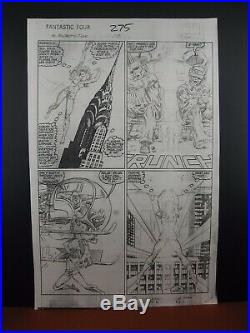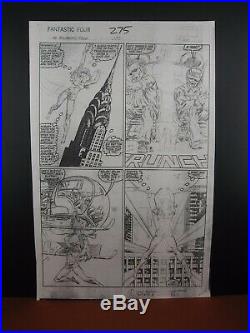



1 #275, PAGE #6. Original Marvel Production Art Pencil Stat. 1 #275, Page #6 – Original Marvel Production Art Pencil Stat, by John Byrne. The piece measures approximately 11 x 17. Raise funds for a very nice lady with medical needs. Check out my other listings! I have had these pieces boxed for decades. You will find that many of these production/internal use pieces are of art that has never been made available to the public. They are of art that still remains in the Marvel archives. Furthermore, there are production/internal use pieces in this collection that are pencil works of great artists – prior to being inked over and permanently lost – very special. I also have a few complete, or nearly complete, books of which I will be listing; so, if interested, let me know. Here are some titles and artists that will be coming soon. George Perez , pencil & Joe Rubinstein, ink. Black Widow – George Perez , pencil. Tom Grummett, pencil & Doug Hazlewood, ink. Doom – Wally Wood , pencil & ink. Tom Raney, pencil & Joe Rubinstein, ink. Defenders – Al Milgrom, pencil & Jack Abel, ink. Marshall Rogers, pencil & Joe Rubinstein, ink. John Buscema , pencil & Tom Palmer, ink. Lately, weve been getting the question What is Original Production Art? Original means that it came straight from Marvel (in the case of my collection, directly from a Marvel employee) and it is not manufactured in a basement or counterfeit in any way (unfortunately, some do that). What is Production Art? Back in the day, before digital technology was used in publishing, there were several forms of production materials left over from the process of publishing a comic-book. Acetates/Transparencies, Stats/Laser Copies, Color Guides, and Surprints/Overlays… These are a few of the different kinds of production art that were created. They each had a different purpose and some could serve multiple purposes. Acetates were used to transfer the image to metal printing plates, color guides were used to show the printer the exact colors for applying to the printing plates, etc. However, starting about 30 years ago, digital technology made production art obsolete. Back in the day, after serving its purpose, production material was not valued at all. Consider it, if you will, equivalent to the material on the cutting room floor in the the old days of Motion Picture production (also made obsolete with digital technology). Now, the collectability of Comic Book Production Art is similar to what happened to Disney Animation Cells. Back in the day, the Comic Book got to the News Stands, just as the Motion Picture got to the Movie Houses, and that was the primary concern. Even before computers made all raw materials obsolete, there were many changes in technology over the decades. For example, early 20th century photostat technology was eventually replaced with laser technology starting in the late 70s – early 80s, but this didnt happen overnight. There was overlap of these technologies (as with others) as the old was phased out. To complicate things more, sometimes earlier files would be pulled for a new project or study/swipe and this earlier work would be Laser copied with the newer machines. Anyway, the publishing house did the technical work necessary to produce a packet of raw materials (Production Art) to be sent out to the Print House Sparta, World Color, etc. The Print House printed the book, not Marvel, DC, etc. The Stat/Laser category of production materials was used for various reasons ranging from retaining an in-house file copy, or used for paste-on & cut-outs, or used for sending the image for checking and approved by various offices such as Art Director, Editor, Legal Department (including mailed offsite at times) and more No one knows how many stats were made of each page back then, it all depended on what was in question, if anything. What is remarkable is that they survived this long, as these raw materials were not valued even after their obsolescence. Heck, there was a time when even original art could be discarded without raising much alarm (as long as the book already made it to the News Stands). Both online and offline. Sure, some original art may exist in private collections with no record of ever changing hands (after all these years, this could account for relatively very little). There is also the fact that Attic Finds of original art have dwindled down to practically nothing the last decade or so reality TV has created an army of Pickers and Storage Warriors over the last 20 years. There is no record and no one knows exactly what art has been lost and or destroyed over the years Many of us have our own stories, or know of original art destroyed in basement floods, fires, and worse Lastly, there is also no record of what remains in Marvels Archives (guarded as Shareholders Assets, now) and those will Never come to public hands but some of it did in the form of production art in the years before corporate restructuring, etc. Virtually nothing has come out of Marvel since then. The first fan clubs were formed in the 70s and as demand for original art grew among this relatively small group of enthusiasts, so did the awareness that a lot of older art had not survived at all. Stories were told of coffee spills and that one would scramble to save the pens, ink and brushes before the art or even use the art to sweep the spill up from seeping further into the table or furniture! Other stories are told of pages received as gifts when very young that were eventually outgrown and left behind or lost, when college or military service came. However, that is only possible if that original page actually still exists and then it depends on IF it will be let go by the collector (dont hold your breath). Production art is an exact representation of the art, often in real size – 11 x 17, but most of all, regardless of size or type acetate/stat/color guide, etc. , it is also a real piece of history as it was actually handled by the staff (artists and production team) who published the original comic book. There are some items that cannot be combined in one package imagine a bowling ball and a picture frame! Instead, add them to your shopping cart first. It is the most reliable in our experience in terms of both tracking and damage security. And tracking information is often not updated until it arrives at its destination. This complicates finding lost packages and or filing damage claims. All items are packed well and insured. However, if anything else, or if there was an error of any kind, we will certainly work out a satisfactory solution. Communication is key, just let us know of any issues there may be. The item “Fantastic Four #275, Page #6 Original Production Art Pencil Stat John Byrne” is in sale since Saturday, August 17, 2019. This item is in the category “Collectibles\Comics\Original Comic Art\Covers”. The seller is “yestro” and is located in Katonah, New York. This item can be shipped to United States, Canada, United Kingdom, Denmark, Romania, Slovakia, Bulgaria, Czech republic, Finland, Hungary, Latvia, Lithuania, Malta, Estonia, Australia, Greece, Portugal, Cyprus, Slovenia, Japan, China, Sweden, South Korea, Indonesia, Taiwan, South africa, Thailand, Belgium, France, Hong Kong, Ireland, Netherlands, Poland, Spain, Italy, Germany, Austria, Bahamas, Israel, Mexico, New Zealand, Philippines, Singapore, Switzerland, Norway, Saudi arabia, Ukraine, United arab emirates, Qatar, Kuwait, Bahrain, Croatia, Malaysia, Brazil, Chile, Colombia, Costa rica, Panama, Trinidad and tobago, Guatemala, El salvador, Honduras, Jamaica, Viet nam, Uruguay, Russian federation.

